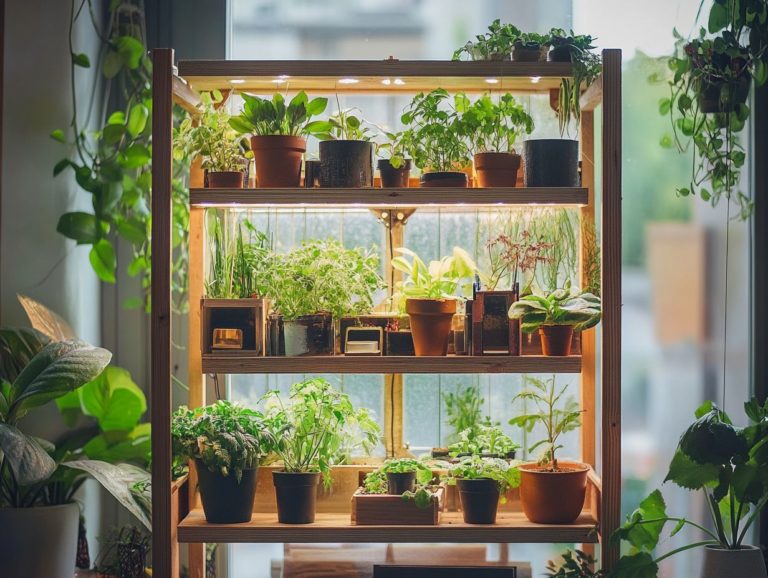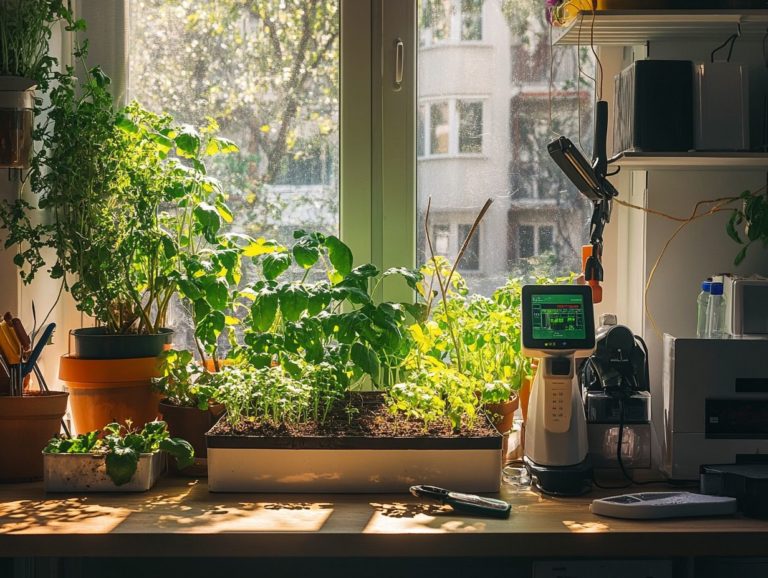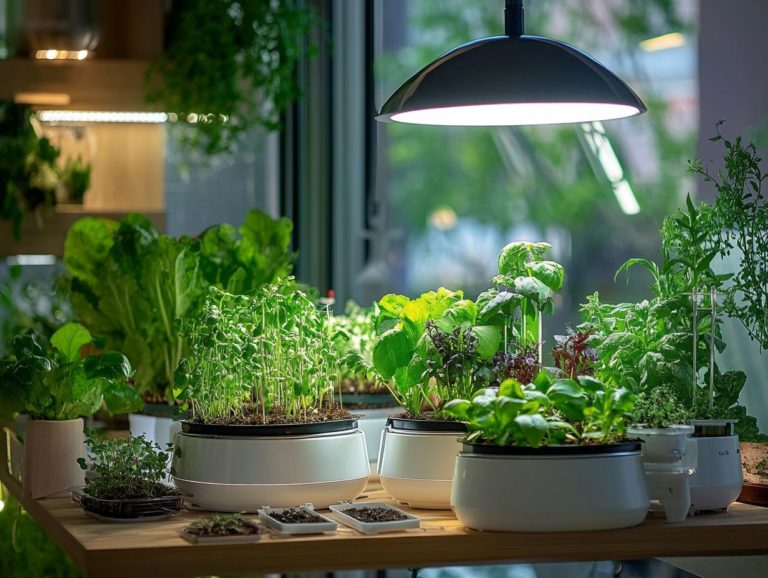Understanding Nutrients for DIY Hydroponic Systems
Hydroponics presents an interesting method for growing plants without soil, instead harnessing nutrient-rich water solutions. Get ready to discover how to create the perfect mix for your plants!
For your plants to flourish in these systems, achieving the right balance of nutrients is crucial. This article delves into the essential role that nutrients play in hydroponic gardening, covering vital macronutrients and micronutrients. Macronutrients are the main nutrients plants need in larger amounts, while micronutrients are needed in smaller quantities.
You’ll learn how to select suitable nutrient solutions and discover DIY recipes for customizing your own mixes. You will also find guidance on how to identify and fix common nutrient problems quickly, ensuring your plants remain healthy and productive.
Whether you’re a seasoned hydroponic gardener or just embarking on this journey, grasping these concepts will empower you to cultivate a thriving garden.
Contents
- Key Takeaways:
- The Role of Nutrients in Hydroponic Systems
- Essential Nutrients for Hydroponic Plants
- How to Choose the Right Nutrients for Your System
- DIY Nutrient Solutions for Hydroponic Systems
- Troubleshooting Nutrient Deficiencies
- Frequently Asked Questions
- What are nutrients and why are they important for DIY hydroponic systems?
- What types of nutrients are needed for DIY hydroponic systems?
- How do I know if my DIY hydroponic system has enough nutrients?
- Can I make my own nutrient solution for DIY hydroponic systems?
- Are there different nutrient requirements for different types of plants in DIY hydroponic systems?
- How often should I change or replenish the nutrient solution in my DIY hydroponic system?
Key Takeaways:
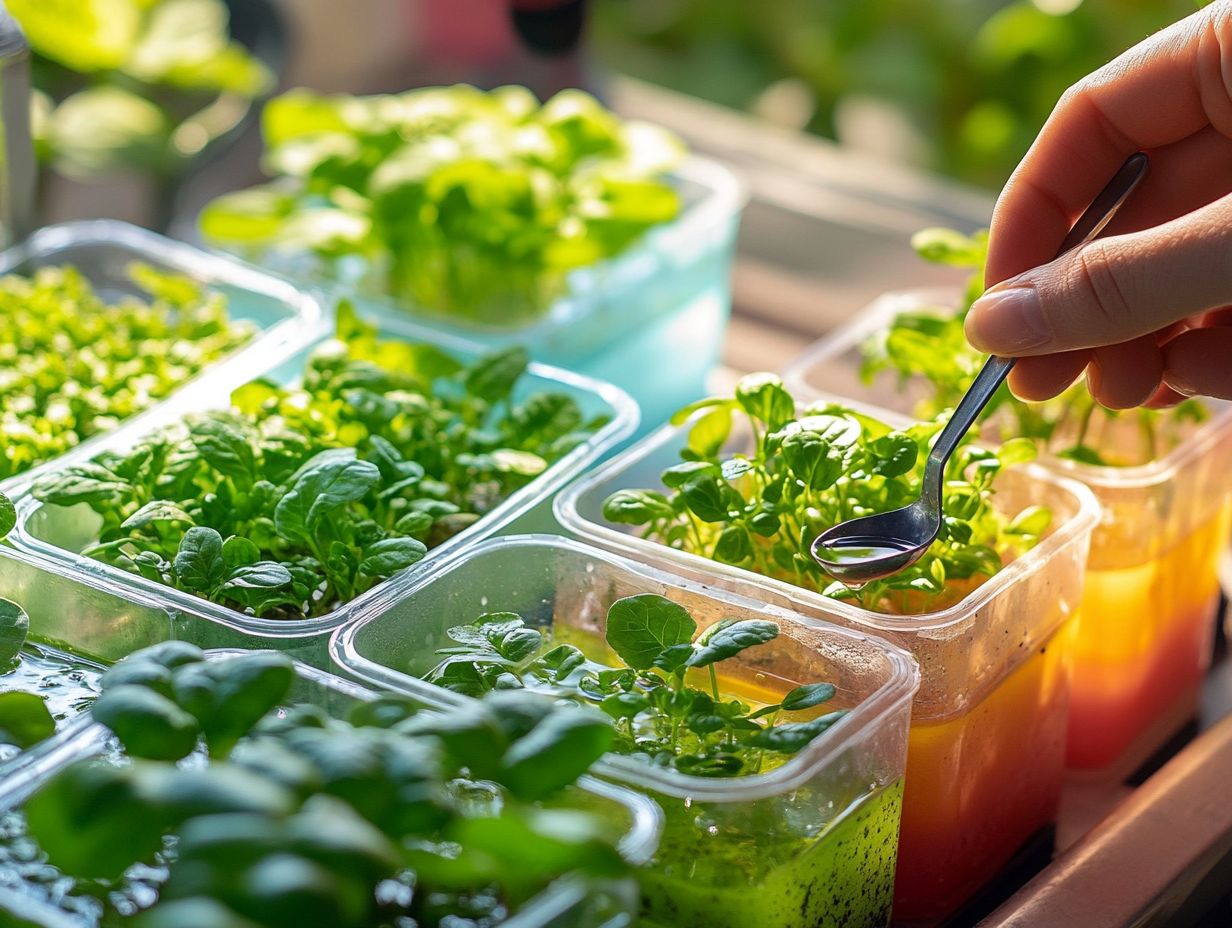
- Understanding the role of nutrients is crucial for successful DIY hydroponic systems.
- Macronutrients and micronutrients are key components in providing essential elements for healthy plant growth.
- Choosing the right nutrients for your system and properly addressing nutrient deficiencies are crucial for maintaining optimal plant growth and yield in hydroponics.
What is Hydroponics?
Hydroponics is an innovative method for growing plants without the need for soil, employing nutrient solutions in a water-based environment to deliver essential nutrients directly to the roots. This technique allows you to exert greater control over growing conditions, including water quality and nutrient levels.
This results in faster growth rates and higher yields compared to traditional farming methods. By utilizing hydroponic systems, you can optimize resource usage, enhance water efficiency, and manage various factors like light and temperature to create the perfect conditions for plant development.
Hydroponics significantly conserves water, using up to 90% less than conventional agriculture thanks to its recirculating systems. This not only leads to cost savings but also minimizes the impact on local water supplies.
The space-saving designs of vertical farming and container systems enable you to cultivate more produce in smaller areas, making it ideal for urban environments. The environmental benefits extend even further, with reduced pesticide use and organic additives, promoting a healthier ecosystem while delivering nutrient-dense food efficiently.
Ultimately, this approach offers a sustainable solution to the pressing global food challenges we face.
The Role of Nutrients in Hydroponic Systems
Nutrients are absolutely vital in hydroponic systems, forming the bedrock of plant health and growth. In these setups, plants depend entirely on nutrient solutions, which must be carefully balanced to deliver the macronutrients and micronutrients essential for optimal development.
For instance, the core macronutrients include Nitrogen, Phosphorus, and Potassium (N-P-K), while elements like calcium, magnesium, and sulfur are equally important for robust plant growth.
To thrive in hydroponics, you need a well-structured fertilizer program tailored to meet the specific nutrient requirements of your various crops. Start your hydroponic journey today and watch your plants thrive!
Why Nutrients are Important
Understanding the significance of nutrients in hydroponic systems is crucial for maintaining healthy plants. Nutrient deficiencies can stunt growth, reduce fruit quality, and increase vulnerability to pests and diseases.
To sidestep these challenges, use complete fertilizers that provide a balanced blend of essential nutrients. Conducting foliar analysis, which is a method of checking plant leaves for nutrient levels, will help you effectively monitor plant health and nutrient uptake.
By regularly assessing the nutrient levels in your hydroponic setup, you can spot signs of deficiency before they snowball into major issues that threaten crop production. Techniques like foliar analysis will give you valuable insights into the specific nutrient requirements of your plants, allowing you to make timely adjustments to your fertilization program.
Embracing advanced monitoring methods, such as soil testing and nutrient solution analysis, ensures that your nutrient supply remains optimal throughout the growth cycle.
Actively managing your nutrients can supercharge plant growth! This not only boosts plant vigor but also results in increased yields and superior quality produce key elements in satisfying market demands.
Essential Nutrients for Hydroponic Plants

For your hydroponic gardening success, grasping the essential nutrients is absolutely critical. These nutrients play a direct role in influencing plant growth and development.
Macronutrients like Nitrogen, Phosphorus, and Potassium are essential for powering a plant s energy processes. Secondary nutrients such as Calcium, Magnesium, and Sulfur contribute to structural integrity and support vital enzymatic functions.
Don’t overlook the micronutrients. Zinc, Copper, and Manganese are needed in smaller amounts, but they play vital roles in plant functions. To achieve optimal plant health in your hydroponic systems, it’s essential to create a well-rounded nutrient solution that addresses both macronutrients and micronutrients. For a deeper understanding, check out the hydroponic nutrient cycle.
Macronutrients and Micronutrients
Macronutrients and micronutrients are the two fundamental categories of nutrients you need to consider for optimal plant health. Each plays unique roles in the growth of your hydroponic crops.
Macronutrients think Nitrogen, Phosphorus, and Potassium are required in larger quantities and are essential for processes like photosynthesis and overall growth. In contrast, micronutrients, such as Boron, Molybdenum, and Chlorine, are vital in trace amounts to facilitate specific biochemical functions.
For instance, the Modified Sonneveld Solution is a well-regarded formula crafted to support tomato plants by delivering a balanced mix of these crucial nutrients. These nutrients collaborate to enhance strong root development, optimize nutrient uptake, and bolster overall plant vigor.
Nitrogen is essential for leaf growth and chlorophyll production. Phosphorus is key for energy transfer and establishing robust roots. Potassium, on the other hand, regulates water loss and ensures your plant’s metabolic functions run smoothly.
Though micronutrients may be needed in smaller amounts, their importance should not be underestimated. They activate enzymes and are pivotal in processes like photosynthesis and nitrogen fixation. The Modified Sonneveld Solution perfectly illustrates how customized nutrient solutions can meet the specific needs of various crops, guaranteeing optimal growth conditions in hydroponic systems.
How to Choose the Right Nutrients for Your System
Selecting the right nutrients for your hydroponic system is a pivotal decision that can profoundly influence both the yield and quality of your crops. There are several factors you should consider, including the specific plant species you re cultivating and their growth stages.
A customized fertilizer program can deliver the essential macronutrients and micronutrients required at different growth phases. Variations in water quality may require adjustments to your nutrient mix, ensuring that your plants receive exactly what they need to thrive.
Factors to Consider
When selecting nutrients for hydroponic systems, several factors come into play, including water quality, potential nutrient deficiencies, and effective agitation methods to guarantee uniform nutrient distribution.
Understanding how each element interacts in your system is vital. This knowledge helps achieve optimal plant growth.
The quality of your water significantly impacts nutrient uptake. Monitor parameters like pH and electrical conductivity closely.
Be vigilant in identifying potential nutrient deficiencies yellowing leaves, for instance, can signal a nitrogen shortfall and prompt necessary adjustments to your nutrient solution. If problems do arise, quick tests can help you pinpoint which nutrients are lacking.
Using appropriate agitation methods, such as air stones or water pumps, is crucial in maintaining a homogenous mix. This ensures that every plant receives an equal distribution of nutrients, leading to healthier, more robust growth.
DIY Nutrient Solutions for Hydroponic Systems
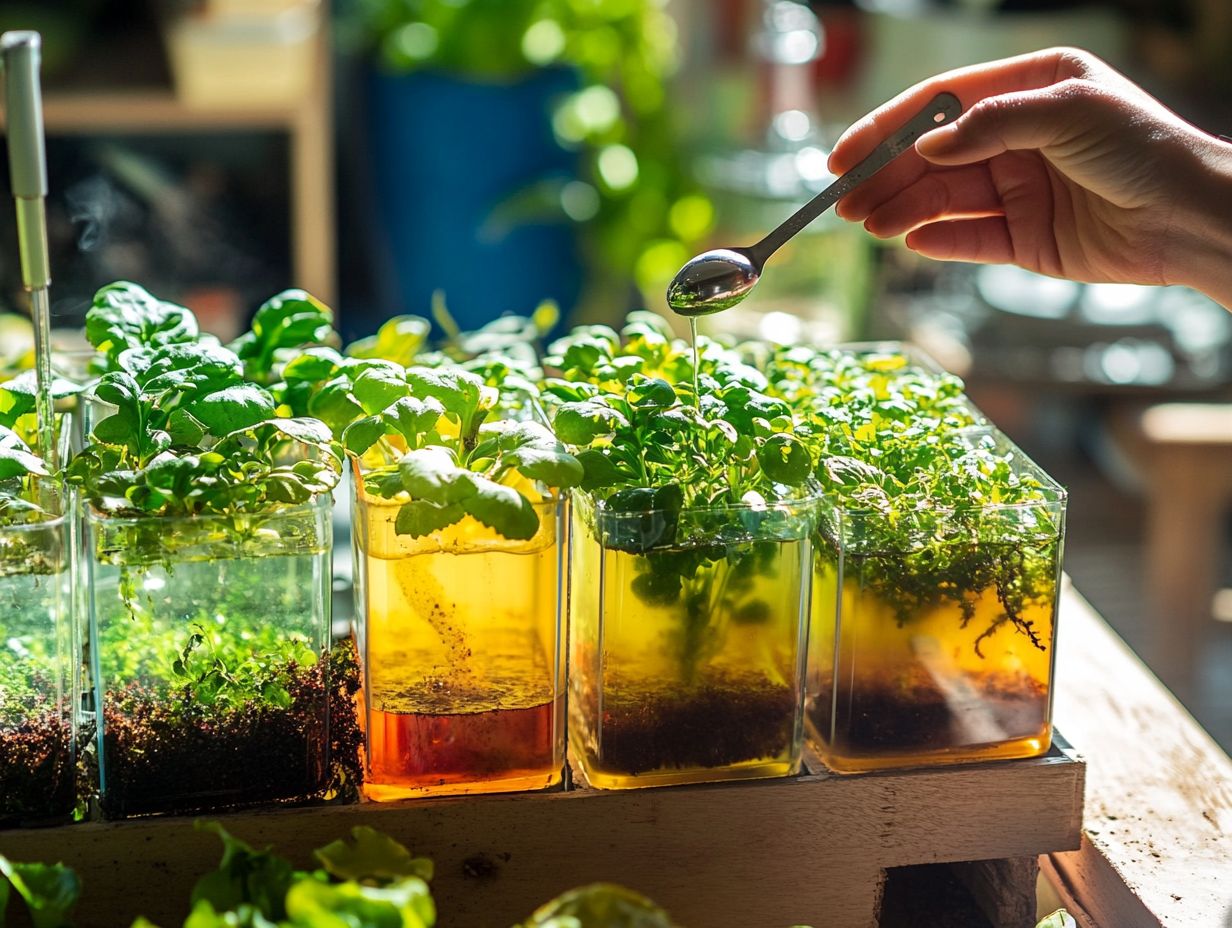
Creating your own DIY nutrient solutions for hydroponic systems is not just budget-friendly; it s a fun way to meet your plants’ unique needs! By blending ingredients like calcium nitrate and magnesium sulfate, you can create a balanced solution that delivers the essential macronutrients and micronutrients vital for robust plant growth.
Furthermore, grasping the N-P-K ratio, which refers to the ratio of nitrogen, phosphorus, and potassium in your fertilizer, is essential for developing comprehensive fertilizers that will nourish your plants at every stage of their growth.
Recipes and Instructions
Here are some straightforward recipes and instructions for you to create DIY hydroponic nutrients tailored to your plants’ specific needs, utilizing formulas like the Modified Sonneveld Solution for optimal results. Begin by preparing a basic nutrient solution with easily accessible ingredients, ensuring that you maintain proper agitation to guarantee even nutrient distribution throughout your system.
A simple formula might include a blend of calcium nitrate and magnesium sulfate, adjusted according to the specific N-P-K ratio required for your plant species. For a basic recipe, mix 15 grams of calcium nitrate with 5 grams of magnesium sulfate per liter of water, stirring thoroughly to dissolve all solids. To learn more about the nutrients needed for optimal growth, check out what nutrients are essential for hydroponics.
If you’re looking for a more customized approach, feel free to adjust the ratios based on your plants growth stages higher Nitrogen for leafy greens and more phosphorus levels for those flowering beauties, using specific formulations like a tomato formula for optimal fruiting results.
It’s essential to keep an eye on the pH and electrical conductivity (EC) of your nutrient solution regularly, as any fluctuations can impact nutrient uptake and overall plant health. Using proper agitation methods, like an aquarium air pump or water circulators, will help ensure that plant nutrients are evenly distributed, preventing sedimentation and enhancing absorption efficiency.
Troubleshooting Nutrient Deficiencies
Troubleshooting nutrient deficiencies is an essential skill for you as a hydroponic grower. By identifying and addressing these imbalances, particularly through monitoring essential elements like Calcium, Magnesium, and trace elements such as Zinc and Copper, you can prevent significant crop losses.
Watch for symptoms like yellowing leaves! These signs mean you must act quickly to revive your plants. You might also notice stunted growth or poor fruit development signals that immediate action is required.
Utilizing methods such as foliar analysis allows you to accurately pinpoint specific nutrient shortfalls, enabling you to adjust your nutrient solutions as needed and ensure optimal plant health.
Identifying and Addressing Nutrient Imbalances
Identifying and addressing nutrient imbalances is crucial for maintaining the health of your hydroponic plants. These imbalances can lead to nutrient deficiencies and overall poor plant vitality. Keep an eye out for common indicators like abnormal leaf coloration, slow growth, and wilting.
Regular testing can help ensure that your plants are receiving all necessary plant nutrients. To tackle these challenges, regularly monitoring water quality and making timely adjustments to your nutrient solutions is essential. Utilizing complete fertilizers that include a wide range of nutrients, such as Sulfur and Chlorine, is key to restoring that all-important balance, as outlined in understanding the nutrient cycle in hydroponics.
For anyone immersed in hydroponics, keeping an eye on pH levels and electrical conductivity can prove extremely beneficial. These factors significantly influence how well your plants absorb plant nutrients. Additionally, using nutrient solutions in different growing systems can enhance your setup. By observing the growth patterns and vigor of your plants, you can gain valuable insights into any potential deficiencies.
Implementing a routine of regular testing using kits to check for specific nutrient levels like Nitrogen, Phosphorus, and Potassium will help you pinpoint exactly what might be lacking, especially when you refer to understanding the fertilizer label in hydroponics.
Selecting fertilizers specifically designed for hydroponic systems, such as those offered by Hydro-Gardens, is vital. Ensure they are water-soluble and contain a balanced ratio of macronutrients and micronutrients. This meticulous approach not only supports vigorous growth but also promotes long-term sustainability in your indoor gardening endeavors. For a deeper understanding, check out understanding the basics of hydroponic systems.
Frequently Asked Questions

What are nutrients and why are they important for DIY hydroponic systems?
Nutrients are essential elements that plants need to grow, such as nitrogen, phosphorus, and potassium. In hydroponic systems, these nutrients are provided in liquid form since there is no soil to naturally supply them. Knowing about nutrients is vital for your DIY hydroponic systems. It helps your plants grow healthy!
What types of nutrients are needed for DIY hydroponic systems?
The three main nutrients needed for plant growth are called macronutrients and include nitrogen, phosphorus, and potassium. In addition to these, plants also require micronutrients, such as calcium, magnesium, and iron. These elements are usually found in commercial hydroponic nutrient solutions, or they can be obtained through organic sources.
How do I know if my DIY hydroponic system has enough nutrients?
Plants will show signs of nutrient deficiencies if they are not receiving enough of certain elements. Signs can include yellowing or browning of leaves, stunted growth, or wilting. It is important to regularly check the pH and nutrient levels of your system to ensure your plants have an adequate supply of nutrients.
Can I make my own nutrient solution for DIY hydroponic systems?
Yes, it is possible to make your own nutrient solution for DIY hydroponic systems using household items or organic materials. However, it is important to carefully research and measure the correct ratios of nutrients. This ensures your plants thrive and flourish!
Are there different nutrient requirements for different types of plants in DIY hydroponic systems?
Yes, different plants have varying nutrient requirements. Research the specific needs of the plants you are growing in your DIY hydroponic system. For example, leafy greens may require higher levels of nitrogen, while fruiting plants may need more phosphorus and potassium. Adjusting the nutrient solution based on plant type will help ensure optimal growth and yields.
How often should I change or replenish the nutrient solution in my DIY hydroponic system?
The frequency of changing or replenishing the nutrient solution depends on the type of system you have and the plants you are growing. Generally, it is recommended to change the solution every 1-2 weeks or when the pH and nutrient levels become unbalanced. Top up with fresh water and nutrients as needed to maintain proper levels. Regular testing and monitoring will help determine the best schedule for your particular setup.

